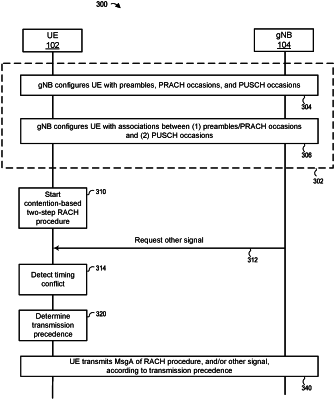| CPC H04W 74/0841 (2013.01) [H04L 5/0051 (2013.01); H04L 25/0226 (2013.01); H04W 72/0446 (2013.01); H04W 72/1263 (2013.01); H04W 72/23 (2023.01); H04W 74/008 (2013.01)] | 20 Claims |

|
1. A user device comprising one or more processors configured to:
select a preamble, or a physical-layer random-access channel (PRACH) occasion, associated with a first time span for the user device to transmit at least a data portion of a random-access procedure message to a base station;
receive, from the base station, a message that grants the user device an occasion to transmit uplink data to the base station on a physical-layer uplink channel (PUSCH) occasion that includes a second time span;
determine that the first time span overlaps the second time span; and
only one of (i) transmit at least the data portion of the random-access procedure message to the base station during the first time span, or (ii) transmit the uplink data to the base station during the second time span, based on a transmission precedence of (i) at least the data portion of the random-access procedure message and (ii) the uplink data,
wherein the PUSCH occasion is a second PUSCH occasion that includes the second time span, and wherein the one or more processors are configured to determine that the first time span overlaps the second time span at least by determining that the selected preamble or the selected PRACH occasion is associated with a first PUSCH occasion that includes the first time span.
|